For houseplant lovers, a pest infestation is the stuff of nightmares. After spending months or even years nurturing our beloved flora friends, the last thing we want is for tiny critters to destroy our efforts. This guide will help you to identify, prevent, and treat, common houseplant pests, ensuring your plants can flourish for years to come.
Common Causes of Houseplant Pest Infestations
‘Prevention is better than cure’ is a phrase that certainly applies to pests! Regularly inspecting your plants and their environment will help you to spot any potential problems early enough to tackle them effectively. Regularly pruning dead or dying leaves from your plants and removing any dead leaves or debris from the soil will also prevent pests, as decaying matter can encourage infestations.
Using already contaminated potting soil is one of the most common causes of infestation. Pests lay their eggs in the soil and attack your plant once potted up. To avoid this, keep your potting soil mixes in an airtight container. Outdoor soil can also harbor all manner of nasties, so when it comes to your houseplants, it’s always best to stick to a specially prepared houseplant mix.
Always check for any signs of infestation before purchasing a new plant, and even if it seems healthy, it’s a good idea to quarantine any new plants for 4- 6 weeks to be on the safe side. You may not even realize that your new baby is hiding pesky bugs, but before you know it, they can spread throughout your whole collection, leaving you with a huge problem.
Keeping many plants close together can make infestations much harder to treat, as they will likely spread from plant to plant very quickly. Pests like scale bugs, for example, can only spread between plants if the leaves are touching, so try to create distance between plants.
Humidity issues can cause several pest problems. Some pests thrive when humidity levels are low, such as spider mites, whereas others, such as fungus gnats will flourish when humidity levels are very high. By the same token, overwatering and standing water can also encourage pests.
A great way to moderate your humidity and moisture levels is to ensure your plants are placed somewhere with good ventilation and air circulation, and always allow plants to drain after you water them.
Stressed, sickly, or unhappy plants will be much more susceptible to infestations. Pay attention to the individual needs of each of your plants and ensure that they are met. A happy plant is a healthy plant!
Common Symptoms of Pest Infestation
Here are some of the warning signs that your houseplants might be infested with pests:
Honeydew
The most easily recognizable symptom of an infestation will be sticky, shiny patches on the leaves, caused by the pests sucking the sweet sap from the plant. This secretion is known as honeydew, and if left untreated, the sugary substance will attract ‘sooty-mold’ fungus, taking on a dark black color.
Yellowing and Discolouration
As the pests suck the sap from the plant, its foliage will begin to yellow and fade. Some pests cause brown, black, or mottled patterns as they pierce the leaves to drink the sap.
Wilting and Leaf drop
As the pests remove the sap, they also remove the nutrients it contains, causing plants to become weak and fragile. Leaves will begin to droop and eventually drop as the structure of the plant is slowly compromised until it can no longer support itself.
Visible infestations
Some pests will be easier to spot than others. Fungus gnats and whitefly, for example, are easily visible because they can be seen flying around the vicinity of affected plants. Other pests are so tiny that they are almost invisible to the naked eye, and the only way of knowing that they are there is by looking out for the symptoms listed above.
Treatments
Here are some of the most effective treatments for getting rid of houseplant pests:
Isolation
The single most important step in any pest treatment is to isolate the affected plant immediately to prevent the infestation spreading to other plants and getting out of hand. Once isolated, you should completely remove any badly affected leaves and stems which will make treating the remaining plant much easier. After treatment, keep the plant in isolation for a few more weeks before reintroducing it to your wider collection.
Neem Oil
Neem oil is an excellent natural pesticide, with the added benefit of having fungicidal and antibacterial properties, which offer protection against disease. Even better, regularly treating healthy plants with neem oil will prevent infestations from taking hold. To make a neem oil spray, dilute 5ml of neem oil in a liter of lukewarm water. Mix well and pour into a clean spray bottle, ready to spritz onto your plants.
Insecticidal Soap
Insecticidal soaps work well because they contain potassium salts of fatty acids which penetrate bugs and cause them to become dehydrated. There’s no need to go out and purchase fancy or expensive products, a homemade solution of gentle dish soap, oil, and water will usually do the trick. The oil will help bind the mixture to the plant, whilst the soap kills the bugs. You can make your own insecticidal soap by combining one gallon of water with 2.5 tablespoons of dish soap, and one tablespoon of vegetable oil. Stir the soap mixture well before spraying it onto plants. There’s no need to rinse the solution off.
Although generally non-toxic, always test the insecticide on a small area of the plant initially to monitor how it reacts before applying it to the whole plant. Insecticidal soaps will also remove honeydew and sooty mold from plants.
Rubbing Alcohol
A solution of rubbing alcohol is incredibly effective at tackling a wide variety of houseplant pests. It works by dissolving the bugs’ protective outer layers and dehydrating their soft body parts. To make a rubbing alcohol solution, mix one-part alcohol with nine parts water and spray over the plants, leaving the solution to soak in over a few days. Always test a small section of the plant first, in case the alcohol burns the foliage.
Chemical pesticides
Whilst organic and natural treatments are usually preferable, especially when treating infestations indoors, sometimes, they may not be potent enough to solve the problem, especially with particularly resilient critters. If natural remedies aren’t working, chemical products may have more success. There is a huge variety of chemical pesticides available which are often tailored to specific plants, pests, and preferences.
Common Houseplant Pests
Here are some of the most common houseplant pests that you should be on the lookout for:
1. Scale
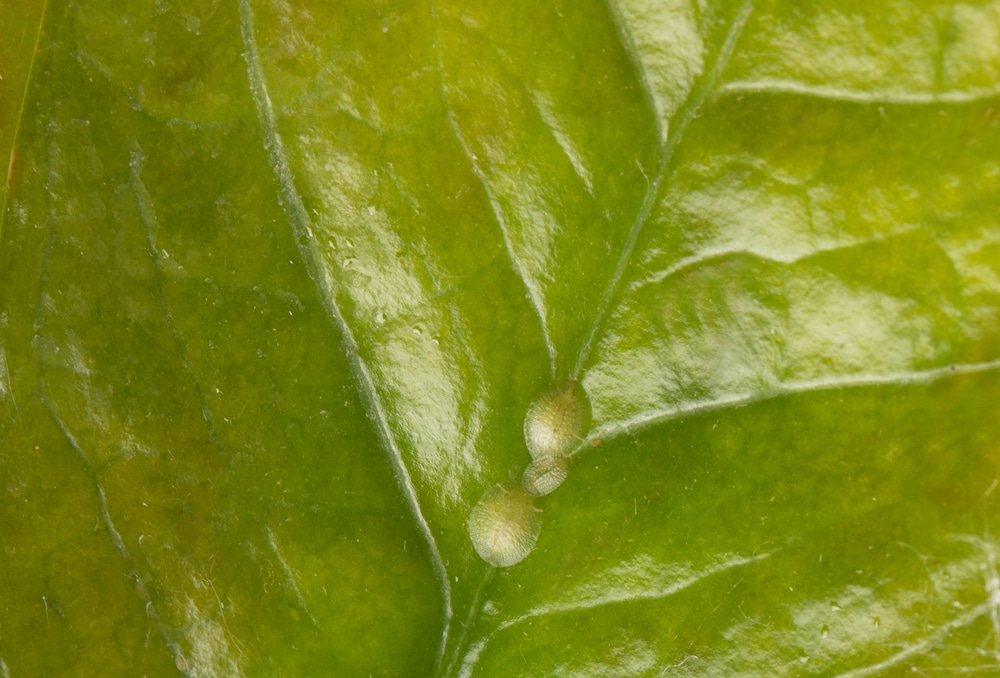
Scale bugs look like little brownish-white bumps or ridges on the stems of plants. As the infestation grows, the bugs will cluster together in unsightly clumps. They suck the sap of the host plant, stunting its growth. They rarely move, so can sometimes be mistaken for a disease or a natural blemish rather than a pest. Look out for shiny, sticky honeydew marks on the foliage, as scale bugs are notorious for secreting this sticky substance.
To treat a scale infestation, gently wipe the stems and foliage with rubbing alcohol using a cotton bud. Scale insects are resistant to some pesticides but can be effectively treated with horticultural oil which suffocates the bugs. You will need to be thorough, as scale bugs like to lurk in crevices and well-hidden areas. It’s best to repeat the treatment process a few times until you are sure that all adults, babies, and eggs have been eradicated. Scale can also live in the soil, so you should remove the plant and repot it in fresh soil and a brand new pot, rinsing the roots off thoroughly in between.
2. Mealybugs
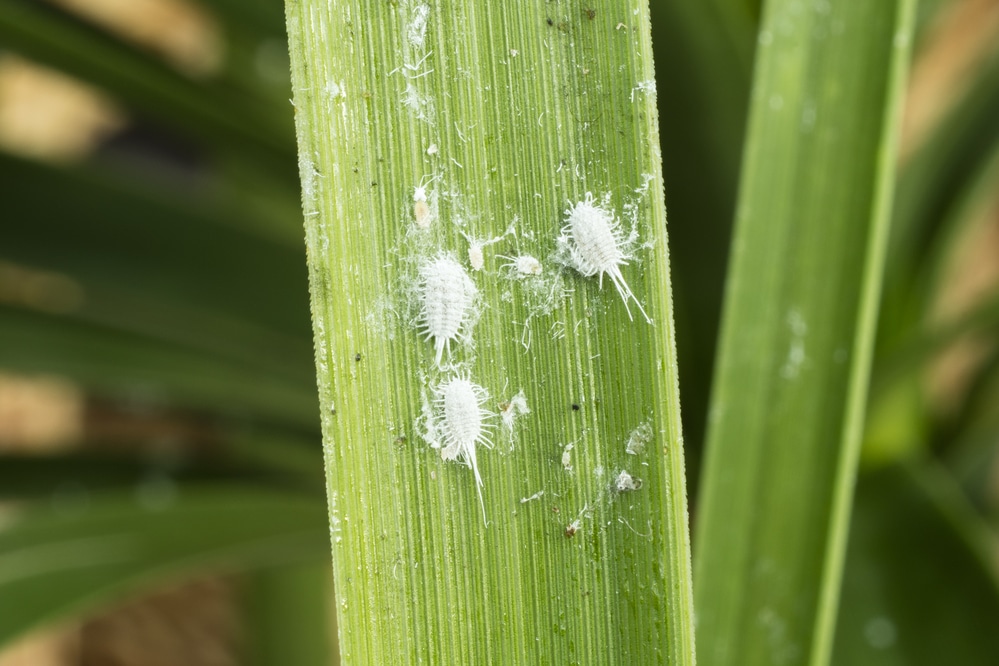
Mealybugs look like tiny white woodlice with a slightly fluffy appearance, similar to cotton wool. They are usually found on the undersides of leaves and in the leaf joints. Mealybugs attack the host plant by sucking its sap and secreting honeydew, which may develop into black fungus. Untreated mealybug infestations will cause foliage to wilt and become yellow, leaves will drop regularly, and eventually, the plant will die.
A rubbing alcohol or neem oil solution either sprayed over the plant or applied with cotton buds should kill mealybugs on contact. Repeat the process daily over a few days until all signs of infestation have disappeared.
3. Whitefly
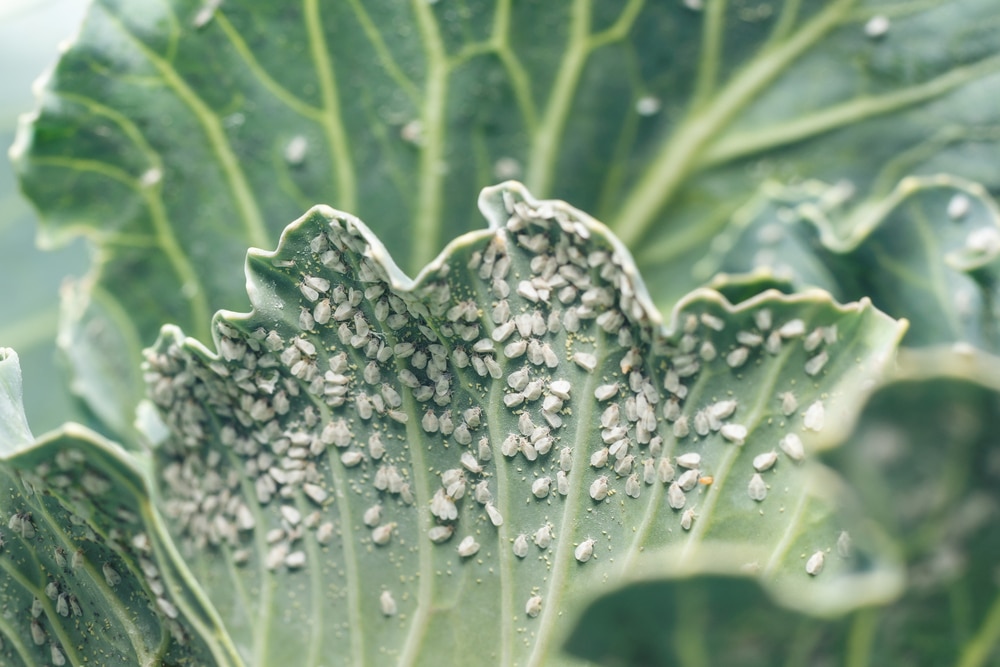
Whiteflies look exactly as their name suggests; tiny white flies! Often found living on the undersides of leaves, they are easy to identify as they will swarm up into the air if the plant is disturbed. They will feed on the sap of your plants, severely stunting growth, and leaving honeydew patches on the leaves. They are much more common during the warmer summer months. Whitefly can reproduce and spread between plants incredibly quickly, so it’s really important to treat them promptly and thoroughly.
A neem oil treatment will be effective only on immobile eggs and larvae. Adults, however, will fly away quickly to avoid the spray, although spraying the plant regularly will disrupt the life cycle of the colony. Sticky traps placed near the affected plants are the best way to catch the mobile adults.
4. Fungus Gnats
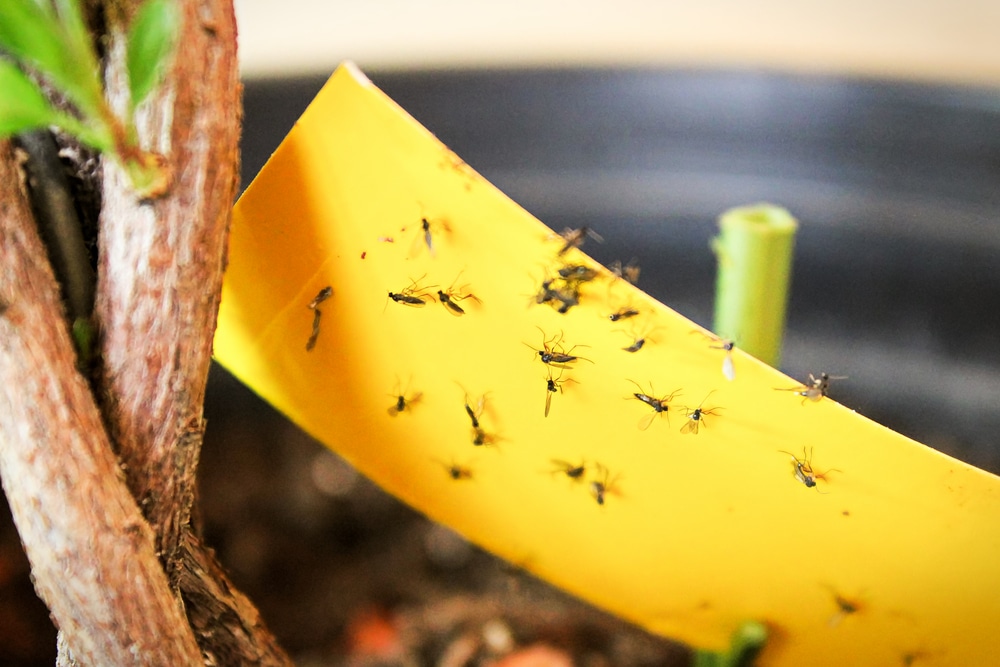
Fungus gnats are tiny black flies, very similar to fruit flies, which tend to live in the soil of plants and can be spotted flying around nearby. They are the most commonly found houseplant pests, but luckily, they do relatively little damage to the plants themselves. They are more of a nuisance than anything else. These pests are particularly partial to warm, wet conditions, so pose a greater threat during the humid summer months. Fungus gnats lay their larvae deep within the soil, and this can damage the plant’s root system if the infestation is particularly large.
Fungus gnats feed on decaying organic matter and fungus, so make sure you remove any dead leaves or other debris from the soil of your plants regularly. Avoid overwatering and over-saturating the surface soil layer particularly, as this creates the wet environment and potential fungal infections which these pests relish. The bottom-watering method is a good way to avoid soggy soil sitting atop the pot. Like whitefly, sticky traps are an effective way to get rid of fungus gnats. A mix of one part 3% hydrogen peroxide with 4 parts water applied to the soil should kill any larvae without damaging the plant’s roots, but you might need to repeat this process a couple of times. You can also repot the affected plant, completely removing any existing soil and replacing it with a fresh potting mix, rinsing the roots thoroughly when you transfer.
5. Aphids
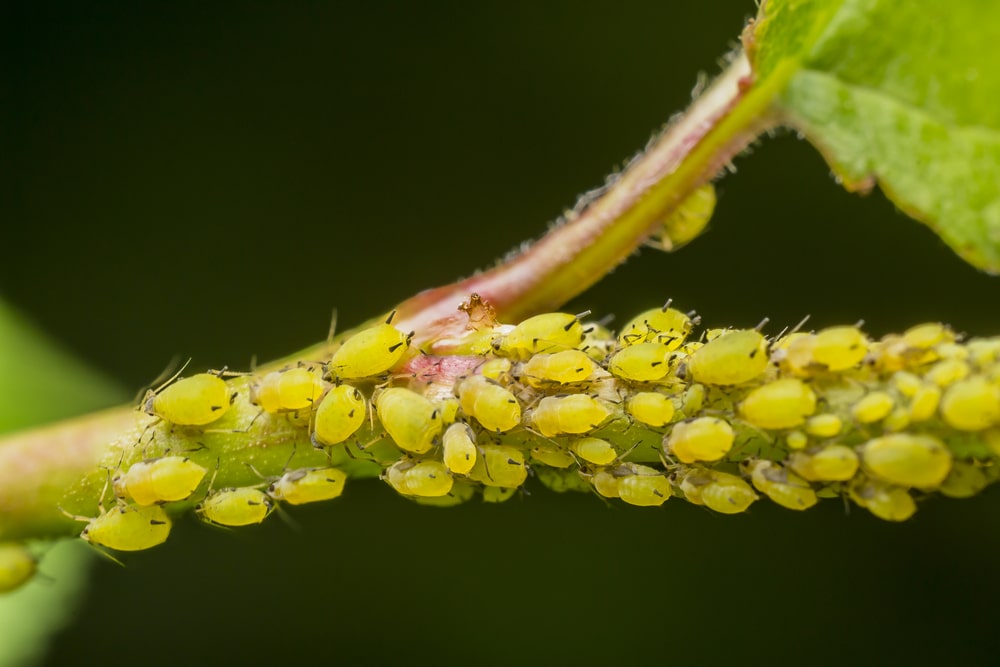
Aphids are tiny fly-like creatures, usually green, but can vary in color from pale yellow to black. They tend to clump together closely, making them easy to spot. They will live on the undersides of leaves and suck the sap from the plant, leading to stunted growth, as well as secreting honeydew on the foliage. Over time, aphid infestations will cause the leaves to curl and yellow, and if left untreated, the plant will die.
Treating aphid infestations is fairly straightforward, and can often be successfully achieved by washing the plant thoroughly with insecticidal soap. Spray the mixture onto the foliage and leave it to soak in well, before carefully wiping each leaf. You may need to repeat the process a couple of times. Performing a similar process with neem oil or rubbing alcohol will also treat aphids effectively.
6. Spider mites
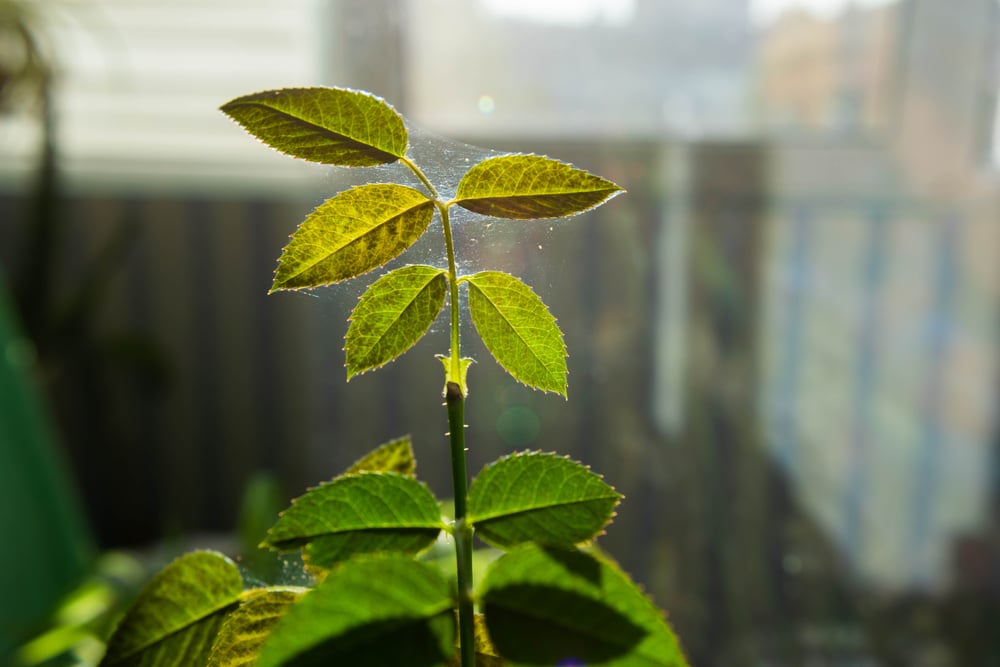
Spider mites are microscopic arachnids that are identified by the fine webs they weave around the host plant. These webs can stretch between plants, enabling them to spread rapidly. Often the bugs themselves are so small that they are invisible to the naked eye. If you do notice the bugs, it usually means that the infestation is particularly heavy. Spider mite infestations can be brutal, causing considerable damage to affected plants. They feed on the sap, leaving an unsightly brown mottled pattern where they pierce the leaves, causing wilting, yellowing, leaf drop, and eventually, death.
Neem oil is an effective treatment for spider mites, but you will probably need several applications to completely eradicate the problem. Spider mites flourish when conditions are dry, so consider increasing the ambient humidity levels if your plant can tolerate it. Regular lukewarm showers will rinse away spider mites whilst increasing the moisture level of the plant. Rubbing alcohol will kill spider mites on contact when applied to the plant, but again, you should repeat the process over a few days.
7. Thrips

Thrips are long, slender black-brown bugs that can be found crawling on or flying around affected plants. They often leave yellow-colored larvae on the leaves. Like other flying pests, they can spread rapidly. They feed on the sap of the plants, stunting and distorting growth, damaging the leaves, and causing the plant to die off. Thrips tend to damage plants at a much faster rate than other houseplant pests, so you will need to act fast.
Thrips tend to be more resilient to natural pesticides than other pests, but you can try treating them with an insecticidal soap or neem oil solution initially. If this method proves unsuccessful, you may want to consider a chemical pesticide instead.

